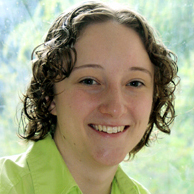Keep Your Eye on Megan Dellinger '05
 When she entered William and Mary in 2001, Megan Dellinger
('05) showed a lot of promise. She was awarded one of two Dow
scholarships given to college freshmen who are prospective chemistry
majors, and she had already participated in chemistry research during
the summer at Carnegie Mellon University.
When she entered William and Mary in 2001, Megan Dellinger
('05) showed a lot of promise. She was awarded one of two Dow
scholarships given to college freshmen who are prospective chemistry
majors, and she had already participated in chemistry research during
the summer at Carnegie Mellon University.
After her freshman year, Megan began to work with inorganic chemist Bob Pike, who assigned her to a project related to the development of hybrid catalysts, one that could prove useful to chemists instigating organic reactions. "Given the amount of work remaining when Megan took over the project, I anticipated that the project would take her the entire summer to complete," Bob wrote in a recommendation for her. "How little did I know Megan. She ran two, three, even four reactions simultaneously, completing the work halfway through the summer." And she has made an impact studying inorganic and organometallic chemistry. Her research focused on using caged phosphite ligands to make metal-organic networks. That involves taking copper atoms and connecting them to molecules to form insoluble networks. Chemists are interested in these networks for their use as heterogeneous catalysts, which are cheaper and easier to remove from solutions than are homogeneous catalysts. Using different ligands alters the pore structure of a network, which could enable chemists to tailor their catalysts to achieve the specific reactions they are looking for during experiments. Megan has collected virtually every award and honor given through William and Mary's chemistry department. As a sophomore, Megan was named a Beckman Scholar, and in her junior year, she was chosen to receive the Iota Sigma Pi National Honor Society for Women in Chemistry Undergraduate Award in a national competition. On Charter Day, she added one more distinction to the list-the 2005 Thomas Jefferson Prize in Natural Philosophy. Megan began graduate studies in chemistry at MIT in the fall of 2005. "I really would like to be a professor", she says, and has worked as a teaching assistant in the chemistry department since her sophomore year. "Ideally, I would like to work somewhere like William and Mary because I really like how it focuses on the undergraduates and how the professors are actively involved in research with the students."















